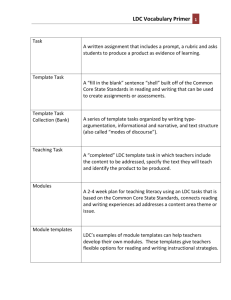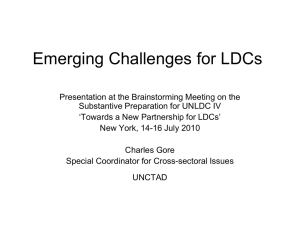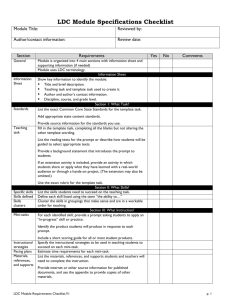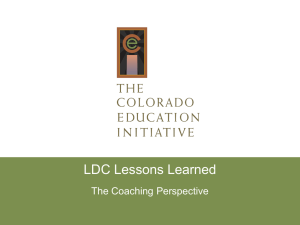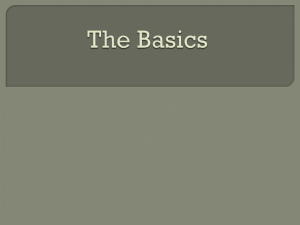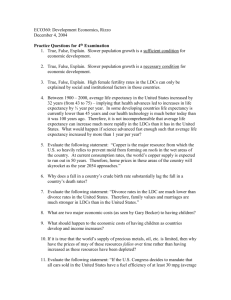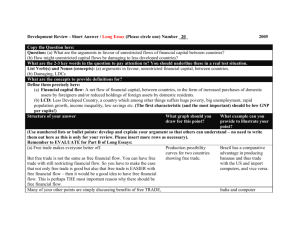Using LDC to Support the Student Growth Process
advertisement
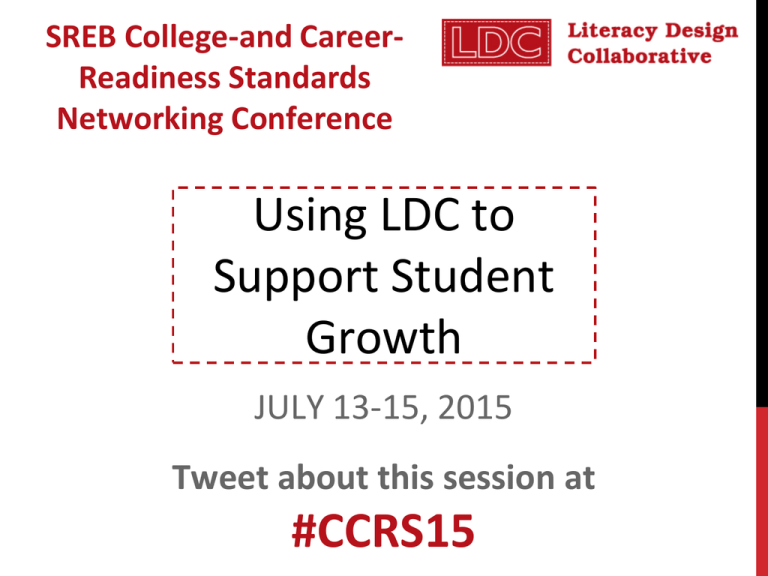
SREB College-and CareerReadiness Standards Networking Conference Using LDC to Support Student Growth JULY 13-15, 2015 Tweet about this session at #CCRS15 Our Facilitators Becky Woosley Effectiveness Coach Kentucky Department of Education rebecca.woosley@education.ky.gov Twitter: @PGEScoach Carol Franks Effectiveness Coach Kentucky Department of Education carol.franks@education.ky.gov Twitter: @caroljunefranks Kelly Philbeck LDC State Lead/Instructional Specialist Kentucky Department of Education kelly.philbeck@education.ky.gov www.kellyphilbeck.com Twitter: @kellyphilbeck #KYLDC FB: KYLDC Presentation Materials SIGN IN ONLINE http://goo.gl/forms/MxwtTYyEjd 4 Connecting the Dots: Using LDC to support the Student Growth Process Ensuring CURRICULUM appropriate alignment of TEACHER EFFECTIVENESS Student Growth INSTRUCTION curriculum, instruction, and ASSESSMENT assessment 5 Our Guiding Questions… • How can teachers use LDC in the student growth process? • How does LDC allow teachers to demonstrate effective teaching? 6 Why use LDC in the Student Growth process? • Template tasks based on the KAS (CCSS) for ELA/Literacy in History/Social Studies, Science and Technical Subjects • Valid, standards-based rubrics aligned to informational, argumentative, and narrative writing • Common rubrics to aggregate data from multiple sources of evidence and to provide formative feedback throughout the instructional process 7 How does LDC help support rigor in the student growth process? 8 Turn and Talk 9 Rigor = Congruency to standards Do the measures provide an opportunity for students to demonstrate mastery of the identified skills, concepts or processes at the level of rigor intended in the standard? 10 What is the KY SG Process? Step 1: Determine needs Step 2: Create specific learning goals based on preassessment Step 3: Create and implement teaching and learning strategies Step 4: Monitor student progress through ongoing formative assessment Step 5: Determine whether students achieved the goals 11 Step 1: Determine needs Step 2: Create specific learning goals based on preassessment Step 3: Create and implement teaching and learning strategies Step 4: Monitor student progress through ongoing formative assessment Step 5: Determine whether students achieved the goals After identifying the Enduring Skills, decide on the appropriate measurement. (Consider - Is writing an appropriate method of measurement for the identified skill?) Use the LDC template tasks to create a classroom assessment as part of the baseline data. NOTE: This writing product is evidence of what students can do independently. After analyzing classroom assessment results, use that data to inform module and/or mini-tasks design - specifically, Section 2 (What Skills?) and Section 3 (What Instruction?). During module implementation, formative assessment data will inform instructional decisions. Build in additional assessments for evidence of students’ abilities to independently apply learning. Use a classroom assessment for summative SGG data for the enduring skill. (An LDC template task may be used for the assessment task.) What’s enduring learning? • ENDURES beyond a single test date • is of value in other disciplines • is relevant beyond the classroom (applying learning to new and unique situations) • is worthy of embedded, course-long focus • may be necessary for the next level of instruction • requires critical thinking (analyzing, creating and evaluating) 13 Let’s take a look at the ELA scenario STEP 1: Determining Need – How did Mrs. Turner decide how to focus her goal and establish a baseline? 14 Contextual vs. Baseline Data • Contextual Data: – Data that informs teachers of where students are performing; aids your decision making for determining an area of focus for enduring skills: state assessments, interim assessments from previous year, common assignment/common assessment data, classroom formative assessments • Baseline Data: – Data that establishes a beginning point of where students are against an enduring skill; provides the starting point for student growth goal-setting 15 Mrs. Turner’s 4th Grade ELA Data 16 17 Mrs. Turner’s 4th Grade ELA Data 18 Mrs. Turner’s Teaching Task Task Template: A3: Does making recess time longer help students do better in school or does it make them do worse in school? After reading informational texts on the pros and cons of extending recess time, write a letter to our principal in which you explain your opinion on whether or not we should extend recess time in our school. Support your opinion with evidence from the texts. For baseline (independent, cold read/write, on demand like, no scaffolding of instruction) to determine baseline 19 LDC Baseline Data Not Yet 1 Approaches Expectations 2 Meets Expectations 3 Exceeds Expectations 4 Focus 15% 42% 38% 5% Controlling Idea 25% 40% 32% 3% Reading/ Research 74% 16% 8% 2% Development 68% 21% 9% 2% Organization 33% 49% 14% 4% Conventions 16% 44% 36% 4% Content Understanding 56% 31% 11% 2% 20 Scoring Elements for Growth 21 Unpacking a 22 Step 2: Create Specific Learning Goals Based on Pre-Assessment Step 1: Determine needs Step 2: Create specific learning goals based on preassessment Step 3: Create and implement teaching and learning strategies Step 4: Monitor student progress through ongoing formative assessment Step 5: Determine whether the student achieved the goals 23 For the 2014-2015 school Time Interval year, all students in my 4th grade class will make measurable progress in supporting an opinion/claim Specific growth need with appropriate and credible details. All students will move Specific growth measure up at least one performance level in Reading/Research and Development and 40% will achieve at least a 3 or better using the 2-5 Opinion Rubric and/or the 2-5 LDC Informational Rubric. 24 23 Step 3: Creating & Implementing Strategies (What skills/instruction?) Step 1: Determine needs Step 2: Create specific learning goals based on preassessment Step 3: Create and implement teaching and learning strategies Step 4: Monitor student progress through ongoing formative assessment Step 5: Determine whether the student achieved the goals 25 Step 4: Monitoring Student Progress and Making Adjustments Step 1: Determine needs Step 2: Create specific learning goals based on preassessment Step 3: Create and implement teaching and learning strategies Step 4: Monitor student progress through ongoing formative assessment Step 5: Determine whether the student achieved the goals 26 Steps 3 & 4 – Time for Teacher Reflection 27 Monitoring the Student Growth Process Monitoring – What & Why What - Monitor both * student progress toward goal attainment * strategy effectiveness through formative assessment processes. Why - Adjust strategies and instruction as needed, while maintaining the goal. 28 It’s what we do with data that’s important – use it authentically to inform practice. 29 SG Process Steps 2-5 Mirror the LDC cycle Step 2 / What Task? Step 3 / What Skills & Instruction? Step 4 / Monitoring learning during mini-task instruction? Step 5 / What Results? 30 STEPS 3 & 4 31 32 CoreTools Mini-Task Library: www.ldc.org https://www.youtube.com/watch?v=0rDLr5dcC8E 33 CoreTools Mini-Task Library: www.ldc.org https://www.youtube.com/watch?v=0rDLr5dcC8E 34 Explore the Rich Resources in the LDC Mini-Task Library Some examples: Dialogue Boxes Double Entry Journal Cornell Notes CER (Claim, Evidence, Reasoning) Close Reading Annotation 35 LDC’s Big Task Bank RI.1 (Insert optional question.) After reading _______________, write a(n) (extended response) in which you explain what the text says explicitly and when drawing inferences. Use details and examples from the text to support your response. RI.2 After reading ______________, write ______________ in which you determine the main idea of the text and explain how key details support the main idea. Include a summary of the text. RI.9 (Insert Optional Question) After reading _________________, write________________ in which you integrate information in order to write or speak about the subject knowledgeably. 36 Engaging Students in Monitoring Their Own Growth 37 Step 5: determining growth Step 1: Determine needs Step 2: Create specific learning goals based on preassessment Step 3: Create and implement teaching and learning strategies Step 4: Monitor student progress through ongoing formative assessment Step 5: Determine whether the student achieved the goals 38 Now, let’s think about how the LDC framework supports effective teaching? 39 How does LDC allow teachers to demonstrate effective teaching? Domain 1: Planning and Preparation Domain 2: Classroom Environment Domain 3: Instruction Domain 4: Professional Responsibilities A. A. Creating an Environment of Respect and Rapport B. Establishing a Culture for Learning C. Managing Classroom Procedures D. Managing Student Behavior E. Organizing Physical Space A. Communicating with Students B. Using Questioning and Discussion Techniques C. Engaging Students in Learning D. Using Assessment in Instruction E. Demonstrating Flexibility and Responsiveness A. B. C. D. B. C. D. E. F. Demonstrating Knowledge of Content and Pedagogy Demonstrating Knowledge of Students Setting Instructional Outcomes Demonstrating Knowledge of Resources Designing Coherent Instruction Designing Student Assessments Reflecting on Teaching Maintaining Accurate Records Communicating with Families Participating in a Professional Community E. Growing and Developing Professionally F. Showing Professionalism 40 How does LDC allow teachers to demonstrate effective teaching? Domain 1: Planning and Preparation A. Demonstrating Knowledge of Content and Pedagogy B. Demonstrating Knowledge of Students C. Setting Instructional Outcomes D.Demonstrating Knowledge of Resources E. Designing Coherent Instruction F. Designing Student Assessments 41 Domain 1 Connections • Teaching task content choice - worthy of extended time • Teaching task appropriate match for content and product • Content standards identified in module and addressed in Skills Ladder • Teaching task engages students • Accommodations embedded in module • Teaching task clearly describes what students will learn • Purposeful LDC mini-tasks lead to measureable outcomes • Intentional sequencing of mini-tasks leads to mastery • Carefully chosen resources for module (beyond textbook) • Grade level appropriate texts (text complexity) • Mini-tasks organized/scaffolded to advance learning, represent cognitive challenges with differentiation of activities/resources • Clear structure: teaching task; standards; skills list; mini-tasks; rubrics (all interdependent) • Reasonable pacing • Formative assessment w/mini-tasks inform instruction • Instructional ladder – intentional and differentiated • Clear criteria (rubric/mini-tasks) 42 How does LDC allow teachers to demonstrate effective teaching? Domain 2: Classroom Environment A.Creating an Environment of Respect & Rapport B.Establishing a Culture for Learning C.Managing Classroom Procedures D.Managing Student Behavior E.Organizing Physical Space 43 Domain 2 Connections •Choice of texts showing multiple perspectives •Students cognitively busy •Students responsible for their learning •Teacher as facilitator of learning •Opportunities for respectful collaboration debate real world connections 44 How does LDC allow teachers to demonstrate effective teaching? Domain 3: Instruction A.Communicating with Students B.Using Questioning and Discussion Techniques C.Engaging Students in Learning D.Using Assessment in Instruction E.Demonstrating Flexibility and Responsiveness 45 Domain 3 Connections • Content scaffold clear and accurate (mini-tasks aligned to standards) • Tasks allows student choice/multiple approaches • Students intellectually engaged (mini-tasks/instruction require analysis and content understanding) • Task design promotes thinking / guides inquiry • Teacher and student facilitated engaging discussions • Opportunities for learner reflection promote metacognition • Task/mini-tasks aligned to a standards/instructional outcomes • Pacing allows for intellectual engagement • formative assessment process informs instruction • Actionable feedback to students facilitate their ability to improve their work 46 How does LDC allow teachers to demonstrate effective teaching? Domain 4: Professional Responsibilities A.Reflecting on Teaching B.Maintaining Accurate Records C.Communicating with Families D.Participating in a Professional Community E.Growing and Developing Professionally F.Showing Professionalism 47 Domain 4 Connections • Teacher self-reflection through anecdotal notes; use of student work; common rubric; collaboration notes • Reflection informs instruction • Use of common LDC rubric lends itself to a growth mindset (student progress) • Job embedded collaborative professional learning • Teachers collaboratively review student work to -identify areas for further instruction -identify gaps in the curriculum -identify effective and ineffective strategies -identify areas for additional professional learning to support their instruction and student learning 48 Our Guiding Questions… • How can teachers use LDC in the student growth process? • How does LDC allow teachers to demonstrate effective teaching? 49 One last reflection … As we implement LDC, how do we (can we) use student growth to change practice? 50 Presentation Materials LDC TEACHER SURVEY https://ldc.org/tell-us-what-you-think 52 CONNECT WITH LDC Check out our website: www.ldc.org Sign up for a free Core Tools Account Ask a question at info@ldc.org Tweet us @LitDesignCollab “Like” us on Facebook www.facebook.com/LitDesCollab 53 Thank You for Joining Us! Questions? Contact: rebecca.woosley@education.ky.gov carol.franks@education.ky.gov kelly.philbeck@education.ky.gov Tweet about this session at #CCRS15 54

